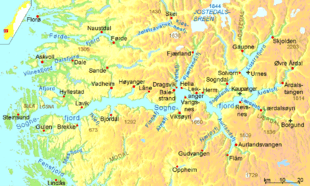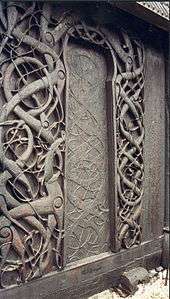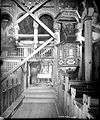Urnes Stave Church
| Urnes Stave Church Urnes stavkyrkje | |
|---|---|
 | |
| Basic information | |
| Location | Ornes, Luster, Sogn og Fjordane county, Norway |
| Geographic coordinates | 61°17′53″N 7°19′21″E / 61.29806°N 7.32250°E |
| Affiliation | Church of Norway |
| Ecclesiastical or organizational status | Church |
| Status | Preserved |
| Architectural description | |
| Architect(s) | Bendik Urne |
| Architectural type | Stave church |
| Architectural style | Romanesque |
| Completed | c. 1132 (dendrochronological dating) |
| Materials | Timber |
| Official name: Urnes Stave Church | |
| Type | Cultural |
| Criteria | i, ii, iii |
| Designated | 1979 (3rd session) |
| Reference no. | 58 |
| State Party |
|
| Region | Europe and North America |
Urnes Stave Church (Norwegian: Urnes stavkyrkje) is a 12th-century stave church at Ornes, along the Lustrafjorden in the municipality of Luster in Sogn og Fjordane county, Norway. It sits on the eastern side of the fjord, directly across the fjord from the village of Solvorn and about 5 kilometres (3.1 mi) east of the village of Hafslo.
It has been owned by Fortidsminneforeningen (Society for the Preservation of Norwegian Ancient Monuments) since 1881. In 1979, the Urnes Stave Church was listed as a World Heritage Site by UNESCO.
History

The church was built around 1130 or shortly thereafter, and still stands in its original location; it is believed to be the oldest of its kind. It provides a link between Christian architecture and the architecture and artforms of the Viking Age with typical animal-ornamentation, the so-called "Urnes style" of animal-art.
Archaeological investigations have discovered the remains of three churches on the site prior to the current building.[1] The excavations uncovered holes in the ground from earth-bound posts which had belonged to an early post church, a type of church with walls supported by short sills inserted between free-standing posts. It is not known if this church had a raised roof above the central space of the nave like the present church. The earliest possible dating of this church is the early eleventh century.
In the 17th century the nave of the church, which is a raised central room surrounded by an aisle, was extended southwards. Other elements were also added to the church, including a baptismal font (1640), a wooden canopy above the altar (1665) and a pulpit (1693–1695). The altarpiece, which depicts Christ on the cross with the Virgin Mary and John the Baptist, dates from 1699. Windows were added to the church in the 18th century.
The church has not been in ordinary use since 1881, when the parish of Urnes was abolished, and it became a part of Solvorn parish in the Indre Sogn deanery of the Diocese of Bjørgvin. It is now only used for special occasions in the parish such as baptisms and weddings.[2][3]
North portal
The portal and other details of the north wall of the present church, as well as the wall planks of the gables, are decorated in classic Urnes-style. They are probably relics from one of the earlier churches. It has been speculated that the portal may originally have been the main portal, facing west.
There have been numerous attempts to interpret the decoration (iconography) of the church's most remarkable part, the old portal in the northern wall. The images are generally considered to represent a snake curling upwards. At the lower end there is an animal with four feet biting the snake.
A common interpretation of this scene is that it portrays the eternal fight between good and evil. The animal is widely believed to be a stylised lion. In Christian iconography the lion is a symbol of Christ, fighting the evil symbolized by the snake, a common representation of Satan.
On the other hand, it is possible that the decoration of the earlier church featured some scenes from Norse mythology, a likely reason for its premature reconstruction in the 12th century. In this context, the animal may be interpreted as Níðhöggr eating the roots of Yggdrasil. "The intertwined snakes and dragons represent the end of the world according to the Norse legend of Ragnarök."[4]
Present building
The church is built with a rectangular nave and a narrower choir. The nave and choir both have raised central spaces. The choir was extended to the east in the 17th century, but this addition was later removed. The drawing by Johan Christian Dahl depicts this, as well as the deteriorated state of the church at that time. During the 20th century the church underwent a restoration, and the richly decorated wall planks were covered to stop further deterioration.
A large number of medieval constructive elements remain in situ: ground beams (grunnstokker), sills (sviller), corner posts (hjørnestolper), wall planks (veggtiler) and aisle wall plates (stavlægjer). The construction of the raised central area with staves, strings and cross braces, and the roof itself, also date from medieval times.
From the previous church on the site remain, in addition to the portal, two wall planks in the northern wall, the corner post of the choir, the western gable of the nave and the eastern gable of the choir.
Media gallery
Building
 Drawing by Johan Christian Dahl
Drawing by Johan Christian Dahl Front view of the church
Front view of the church Exterior view of the church site
Exterior view of the church site
Carvings
.jpg) Carvings on door jambs and a wall plank of the north wall
Carvings on door jambs and a wall plank of the north wall North door with carved doorjambs
North door with carved doorjambs.jpg) Right doorjamb of the north door
Right doorjamb of the north door.jpg) Lintel of the north door
Lintel of the north door.jpg) Detail of carving on the left jamb of the north door
Detail of carving on the left jamb of the north door.jpg) Detail of carving on left jamb of north door
Detail of carving on left jamb of north door
Interior
 Pilgrim at a capital on top of a stave
Pilgrim at a capital on top of a stave Figure of the Madonna
Figure of the Madonna Centaur on the capital of a stave or column
Centaur on the capital of a stave or column Interior view of the church, 1937
Interior view of the church, 1937
Literature
- Krogh, Knud J. (2011): Urnesstilens kirke – Forgængeren for den nuværende kirke på Urnes. Oslo. ISBN 978-82-530-3400-3
References
- ↑ Krogh, Knud J. (2011) pp. 10 and 211-215
- ↑ "Urnes stavkyrkje". Kirkesøk: Kirkebyggdatabasen. Retrieved 2014-02-20.
- ↑ "Oversikt over Nåværende Kirker" (in Norwegian). KirkeKonsulenten.no. Retrieved 2014-02-20.
- ↑ Fazio, Michael W.; Moffett, Marian; Wodehouse, Lawrence (2003). A World History of Architecture. McGraw-Hill Professional. p. 201. ISBN 978-0-07-141751-8.
- This article is based on a translation of the corresponding article from the Norwegian Wikipedia, retrieved on 14 April 2005 and updated on 15 October 2005.
External links
 Media related to Urnes stavkirke at Wikimedia Commons
Media related to Urnes stavkirke at Wikimedia Commons- Urnes stave church in Stavkirke.info — in Norwegian
- Urnes stave church in Fortidsminneforeningen — in Norwegian
- Fortidsminneforeningens stave church pages — in Norwegian (there are also English and German pages)
- Description and pictures of Urnes stave church — in Dutch